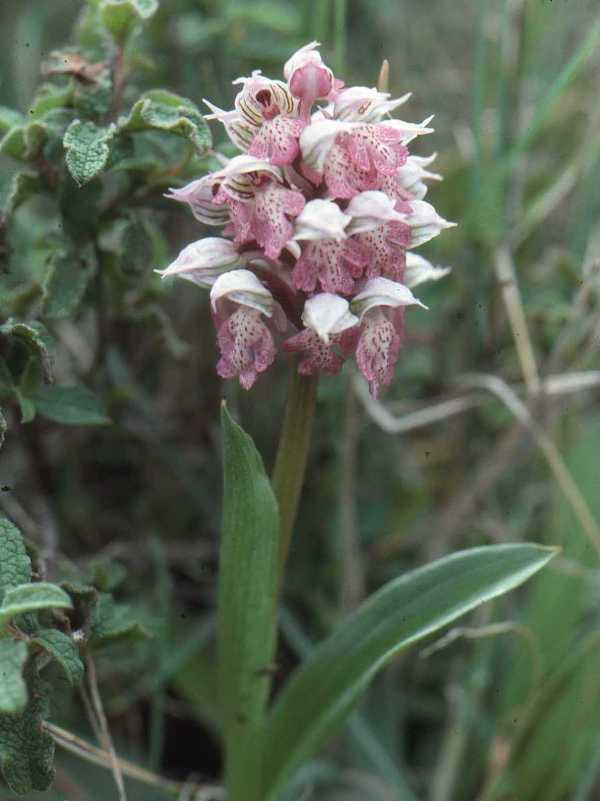Neotinea tridentata subsp. lactea - Milky Orchid
Phylum: Magnoliophyta - Class: Liliopsida - Order: Orchidales - Family: Orchidaceae

Picture by kind permission of Anne Horsfall
Three very similar looking orchids, Orchis conica, Orchis lactea and Orchis tridentata have recently been moved from the Orchis genus to the Neotinea genus where they join the former Orchis intacta which is now called Neotinea maculata. Despite their large geographical range, many authorities have long suspected that the morphological similarities between O. conica, O. lactea and O. tridentata indicate a very close relationship, and this has now been confirmed by molecular study. These orchids are now sometimes simply referred to by the synonyms Neotinea conica, Neotinea lactea and Neotinea tridentata.
Description
The common name of this orchid refers to the colour of the flowers, which are a pale milky colour although the lip is densely marked with dark dots and streaks. Neotinea lactea is a small plant growing only to around 25cm tall. It has 3-5 erect basal leaves which are pale green and unmarked, and there are further small bract-like leaves sheathing the lower stem. The inflorescence is dense and the number of flowers is very variable. The flower sepals and petals are marked with dark green veins and form a hood above the lip. The lip is deeply lobed, usually a creamy colour and marked with dark pink spots. The central lobe is convex and bent backwards.
Distribution
There is some debate about the extent of this orchid's range in the Mediterranean due to confusion with the similar orchids (mentioned above) Neotinea conica in the west and Neotinea tridentata in other parts of the range. It is recorded from France, Italy, Crete and Corsica.
Habitat
The Milky Orchid grows in open grassy places, in scrub and abandoned farmland
Flowering times
End of February to tbe beginning of April.
The picture on this page was taken in Crete.
Etymology
The genus name Neotinea honours the Sicilian botanist Vincenzo Tineo (1791 - 1856), while the specific epithet lactea means 'milky'.
Reference sources
The Plant List
Sue Parker (2023) Wild Orchids of the Algarve - where, when and how to find them; First Nature e-book (Amazon Kindle format)
Chris Thorogood and Simon Hiscock (2014) Field Guide to the Wildflowers of the Algarve; Kew Publishing
Pierre Delforge (2005) Orchids of Europe, North Africa and the Middle East; A&C Black
Fielding, Turland and Mathew (2005) Flowers of Crete; Kew
Please Help Us: If you have found this information interesting and useful, please consider helping to keep First Nature online by making a small donation towards the web hosting and internet costs.
Any donations over and above the essential running costs will help support the conservation work of Plantlife, the Rivers Trust and charitable botanic gardens - as do author royalties and publisher proceeds from books by Pat and Sue.


